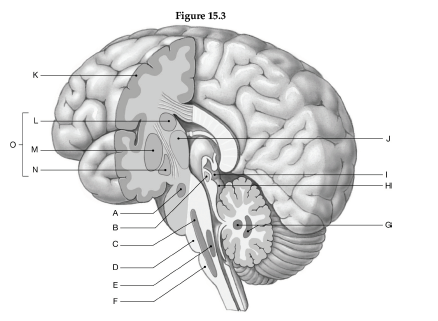Using the figure below, identify the labeled part.

1) Label A: ______________________________
2) Label B: ______________________________
3) Label C: ______________________________
4) Label D: ______________________________
5) Label E: ______________________________
6) Label F: ______________________________
7) Label G: ______________________________
8) Label H: ______________________________
9) Label I: ______________________________
10) Label J: ______________________________
11) Label K: ______________________________
12) Label L: ______________________________
13) Label M: ______________________________
14) Label N: ______________________________
15) Label O: ______________________________
1) Red nucleus
2) Tectum
3) Reticular formation
4) Pons
5) Vestibular nucleus
6) Medulla oblongata
7) Cerebellar nuclei
8) Inferior colliculus
9) Superior colliculus
10) Thalamus
11) Motor cortex
12) Caudate nucleus
13) Putamen
14) Globus pallidus
15) Basal nuclei
You might also like to view...
The display of chromosome pairs arranged by size and similar features is known as the
A. genotype. B. Punnet square. C. karyotype. D. heredity gel.
Hemoglobin has the greatest affinity for
a. carbon dioxide b. oxygen c. carbon monoxide d. nitrogen e. sulfur dioxide
What is the function of the ductus deferens?
A) stores sperm and transports sperm to the ejaculatory duct B) produces sperm and secretes testosterone C) secretes the majority of semen D) produces alkaline, mucus secretions E) carry fluid from the seminal gland and ampulla to the urethra
An embryonic cell that has the potential to develop into a wide range of tissues is called a/an
A. differentiated cell. B. multipotent cell. C. pluripotent cell. D. omnipotent cell. E. totipotent cell.